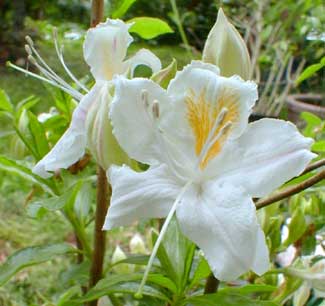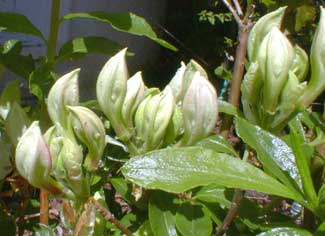
Western
Azalea
"Sandy was very drunk. He was lying under an azalea bush, in pretty much the same attitude in which he had fallen some hours before."
"The Idyl of Red Gulch"
by Bret Harte
(1839-1902"
by Bret Harte
(1839-1902"
The Pacific or Westen Azalea, Rhododendron occidentale, is a wild azalea native mainly to southern Oregon & northwestern California, west of the Cascades & the Sierras. Vagrant populations occur further south along the front of the Sierra Mountains & as far north as southern Washington.
John Muir encountered the shrub in the Yosemite region & said of it, "It is very showy & fragrant, & everybody must like it not only for itself but for the shady alders & willows, ferny meadows, & living water associated with it."
It grows in wetlands, bogs, or seepage areas & along creek edges. In the garden it wants moist well-draining soil, can be rather tolerant of outright wetness such as would cause root-rot in most deciduous azaleas, but is not drought tolerant.
 It's additionally more tolerant of alkalinity than are most rhododendrons & azaleas, though our naturally acidic soils are probably best. In the Northwest it is an easy shrub to grow, but reports from outside the Northwest are more mixed, & as a species it may be a little more difficult than its hybrids. Regions with hot humid summers are apparently out of hte question for growing this azalea.
It's additionally more tolerant of alkalinity than are most rhododendrons & azaleas, though our naturally acidic soils are probably best. In the Northwest it is an easy shrub to grow, but reports from outside the Northwest are more mixed, & as a species it may be a little more difficult than its hybrids. Regions with hot humid summers are apparently out of hte question for growing this azalea.Fluffy flower buds are attractive late in April, & it is in full flower in May. The usual color is white with yellow dorsal blotch which ranges from mild freckling to deep bright gold. There are races that are rosy pink. Size of trusses varies too; young plants like ours may have only two to five trumpets per truss, but an old shrub can have trusses with three or four dozen trumpets in one truss.
It is regionally called a honeysuckle shrub because the flowers are so wonderfully redolent, the sweet scent can be detected from a long way off.
It can grow to fifteen feet as a large, open, twiggy shrub or small tree, though in the garden four to six foot specimens are large. It's slow-growing, & its ten year size is three to five feet.
The Western Azalea has been an important plant in breeding programs, having first found its way into the hands of European growers by the 1850s. Among the huge number of hybrids that exist, we have 'Washington State Centennial' & a nameless hybrid of R. occidentalis x calendulaceum 'Colossus,' this latter dubbed our Western Flame Azalea.
Green seed pods ripen to brown then become woody & open into five-point stars, looking like wee winter flowers carved of wood.
It's often stated that the Western Azalea is the only azalea native of the western rockies, but that discounts the difficult-to-grow Cascade Mountain Azalea R. albiflorum.
The green comma butterfly & the hoary comma are attracted by the western azalea. It also attracts bees which seem to be largely unaffected by the toxins. Leaves of the Western Azalea are toxic & if it were possible to choke down enough of the leaves, they would cause intoxication & possibly serious illness; see the article on Mad Honey for fuller discussion of rhododendron grayanotoxins.